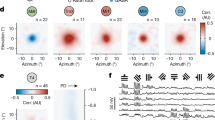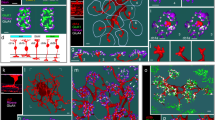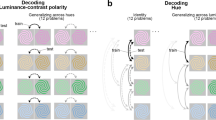Abstract
Multiplicative operations are important in sensory processing1,2,3,4,5, but their biophysical implementation remains largely unknown5,6,7,8,9,10. We investigated an identified neuron (the lobula giant movement detector, LGMD, of locusts) whose output firing rate in response to looming visual stimuli has been described by two models, one of which involves a multiplication. In this model, the LGMD multiplies postsynaptically two inputs (one excitatory, one inhibitory) that converge onto its dendritic tree11,12; in the other model, inhibition is presynaptic to the LGMD13,14. By using selective activation and inactivation of pre- and postsynaptic inhibition, we show that postsynaptic inhibition has a predominant role, suggesting that multiplication is implemented within the neuron itself. Our pharmacological experiments and measurements of firing rate versus membrane potential also reveal that sodium channels act both to advance the response of the LGMD in time and to map membrane potential to firing rate in a nearly exponential manner. These results are consistent with an implementation of multiplication based on dendritic subtraction of two converging inputs encoded logarithmically, followed by exponentiation through active membrane conductances.
This is a preview of subscription content, access via your institution
Access options
Subscribe to this journal
Receive 51 print issues and online access
$199.00 per year
only $3.90 per issue
Buy this article
- Purchase on Springer Link
- Instant access to full article PDF
Prices may be subject to local taxes which are calculated during checkout




Similar content being viewed by others
References
Reichardt, W. Autokorrelations-Auswertung als Funktionsprinzip des Zentralnervensystems. Z. Naturforsch. 12, 448–457 (1957)
Barlow, H. B. & Levick, W. R. The mechanisms of directionally selective units in rabbit's retina. J. Physiol. (Lond.) 178, 477–504 (1965)
McAdams, C. J. & Maunsell, J. H. R. Effects of attention on orientation-tuning functions of single neurons in macaque cortical area V4. J. Neurosci. 19, 431–441 (1999)
Sun, H. & Frost, B. J. Computation of different optical variables of looming objects in pigeon nucleus rotundus neurons. Nature Neurosci. 1, 296–303 (1998)
Pena, J. L. & Konishi, M. Auditory spatial receptive fields created by multiplication. Science 292, 249–252 (2001)
Torre, V. & Poggio, T. A synaptic mechanism possibly underlying directional selectivity to motion. Proc. R. Soc. Lond. B 202, 409–416 (1978)
Andersen, R. A., Essick, G. K. & Siegel, R. M. Encoding of spatial location by posterior parietal neurons. Science 23, 456–458 (1985)
Yuste, R. & Tank, D. Dendritic integration in mammalian neurons, a century after Cajal. Neuron 16, 701–716 (1996)
Koch, C. Biophysics of Computation: Information Processing in Single Neurons (Oxford Univ. Press, Oxford, 1998)
Chance, F. S., Abbott, L. F. & Reyes, A. D. Gain modulation from background synaptic input. Neuron 35, 773–782 (2002)
Hatsopoulos, N., Gabbiani, F. & Laurent, G. Elementary computation of object approach by a wide-field visual neuron. Science 270, 1000–1003 (1995)
Gabbiani, F., Krapp, H. G. & Laurent, G. Computation of object approach by a wide-field, motion-sensitive neuron. J. Neurosci. 19, 1122–1141 (1999)
Rind, F. C. & Bramwell, D. I. Neural network based on the input organization of an identified neuron signaling impending collision. J. Neurophysiol. 75, 967–985 (1996)
Rind, F. C. Intracellular characterization of neurons in the locust brain signaling impending collision. J. Neurophysiol. 75, 986–995 (1996)
Wagner, H. Flow field variables trigger landing in flies. Nature 297, 147–148 (1982)
Wicklein, M. & Strausfeld, N. J. Organization and significance of neurons that detect change of visual depth in the hawk moth Manduca sexta. J. Comp. Neurol. 424, 356–376 (2000)
Schlotterer, G. R. Response of the locust descending movement detector neuron to rapidly approaching and withdrawing visual stimuli. Can. J. Zool. 55, 1372–1376 (1977)
Rind, F. C. & Simmons, P. J. Orthopteran DCMD neuron: a reevaluation of responses to moving objects. I. Selective responses to approaching objects. J. Neurophysiol. 68, 1654–1666 (1992)
Robertson, R. M. & Johnson, A. G. Retinal image size triggers obstacle avoidance in flying locusts. Naturwissenschaften 80, 176–178 (1993)
Gabbiani, F., Mo, C. & Laurent, G. Invariance of angular threshold computation in a wide-field looming-sensitive neuron. J. Neurosci. 21, 314–329 (2001)
O'Shea, M. & Rowell, C. H. F. Protection from habituation by lateral inhibition. Nature 254, 53–55 (1975)
Rowell, C. H. F., O'Shea, M. & Williams, J. L. D. The neuronal basis of a sensory analyser, the acridid movement detector system. IV. The preference for small field stimuli. J. Exp. Biol. 68, 157–185 (1977)
Rind, F. C. & Simmons, P. J. Local circuits for the computation of object approach by an identified visual neuron in the locust. J. Comp. Neurol. 395, 405–415 (1998)
Rauh, J. J., Lummis, S. C. R. & Sattelle, D. B. Pharmacological and biochemical properties of insect GABA receptors. Trends Pharmacol. 11, 325–329 (1990)
Warzecha, A. K., Egelhaaf, M. & Borst, A. Neural circuit tuning fly visual interneurons to motion of small objects. 1. Dissection of the circuit by pharmacological and photoinactivation techniques. J. Neurophysiol. 69, 329–339 (1993)
Zanker, J. M., Srinivasan, M. V. & Egelhaaf, M. Speed tuning in elementary motion detectors of the correlation type. Biol. Cybern. 80, 109–116 (1999)
Mead, C. Analog VLSI and Neural Systems (Addison-Wesley, Boston, 1989)
Koch, C., Bernander, O. & Douglas, R. J. Do neurons have a voltage or a current threshold for action potential initiation? J. Comput. Neurosci. 2, 63–82 (1995)
Rowell, C. H. F. in Experimental Analysis of Insect Behavior (ed. Browne, L. B.) 87–99 (Springer, New York, 1974)
Galant, A. R. Non-linear Statistical Models (Wiley & Sons, New York, 1987)
Acknowledgements
We thank C. Mo for technical assistance with the experiments presented in Fig. 2, S. Potter for help with two-photon confocal microscopy, and J. Maunsell for comments. This work was supported by the Sloan Foundation, the National Institute of Mental Health (F.G., C.K.), the National Institute for Deafness and Communication Disorders (G.L.), the McKnight Foundation (G.L.) and the Center for Neuromorphic Engineering as part of the NSF Engineering Research Center programme. H.G.K. was supported by a travel grant of the Deutsche Forschungsgemeinschaft. F.G. is an Alfred P. Sloan research fellow.
Author information
Authors and Affiliations
Corresponding author
Ethics declarations
Competing interests
The authors declare that they have no competing financial interests.
Supplementary information
Rights and permissions
About this article
Cite this article
Gabbiani, F., Krapp, H., Koch, C. et al. Multiplicative computation in a visual neuron sensitive to looming. Nature 420, 320–324 (2002). https://doi.org/10.1038/nature01190
Received:
Accepted:
Issue Date:
DOI: https://doi.org/10.1038/nature01190
This article is cited by
-
Escape behaviors in prey and the evolution of pennaceous plumage in dinosaurs
Scientific Reports (2024)
-
Ultra-low power neuromorphic obstacle detection using a two-dimensional materials-based subthreshold transistor
npj 2D Materials and Applications (2023)
-
Neural Circuit Mechanisms Involved in Animals’ Detection of and Response to Visual Threats
Neuroscience Bulletin (2023)
-
Approaching object acceleration differentially affects the predictions of neuronal collision avoidance models
Biological Cybernetics (2023)
-
Event-driven proto-object based saliency in 3D space to attract a robot’s attention
Scientific Reports (2022)
Comments
By submitting a comment you agree to abide by our Terms and Community Guidelines. If you find something abusive or that does not comply with our terms or guidelines please flag it as inappropriate.



